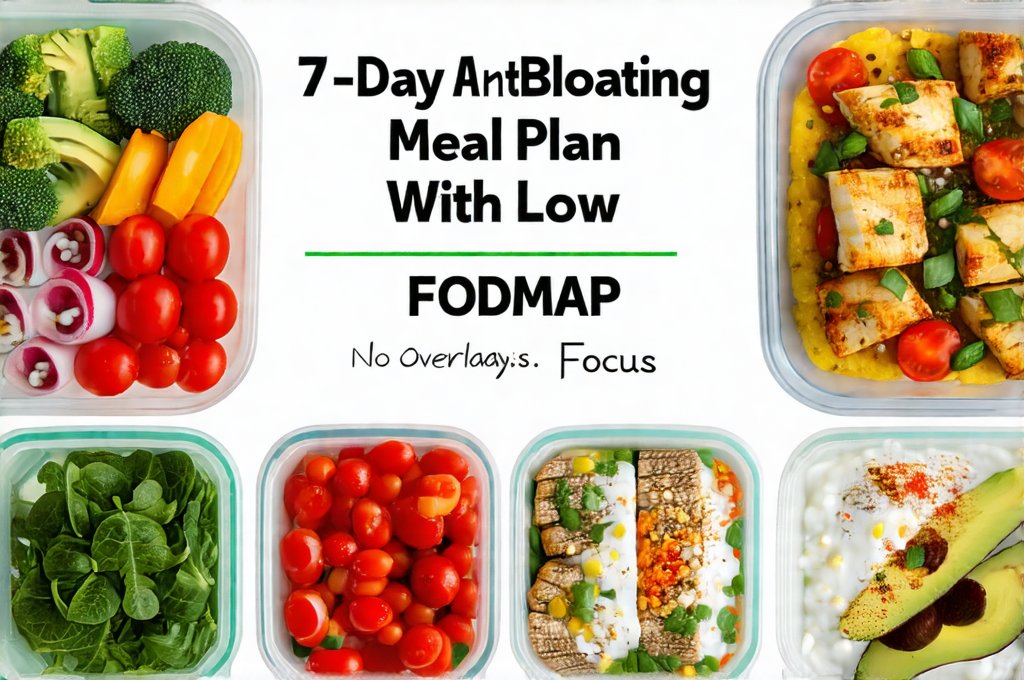Bloating is an incredibly common digestive complaint, affecting millions worldwide. It’s often dismissed as simply “having gas,” but for many, it’s a debilitating experience that can significantly impact quality of life. Beyond the discomfort—the feeling of fullness, pressure, and even visible abdominal distension—bloating can be accompanied by symptoms like cramping, excessive gas, diarrhea or constipation, and fatigue. While there are numerous potential causes, ranging from food sensitivities to underlying medical conditions, dietary factors frequently play a significant role. Many individuals find relief by addressing their diet, specifically focusing on eliminating foods that trigger inflammation and optimizing gut health.
This 7-day anti-bloating meal plan is designed with this in mind, centering around the principles of a low-FODMAP diet. FODMAPs – Fermentable Oligosaccharides, Disaccharides, Monosaccharides, And Polyols—are types of carbohydrates that are poorly absorbed by the small intestine. When these undigested carbs reach the large intestine, they become fermented by gut bacteria, leading to gas production and subsequent bloating. A low-FODMAP diet isn’t necessarily a long-term solution for everyone, but it’s an incredibly effective tool for identifying trigger foods and providing temporary relief while you work toward understanding your individual digestive sensitivities. This plan offers a structured approach, focusing on easily digestible foods and minimizing potential irritants to help you reclaim comfort and confidence. You might also benefit from learning about creating an anti-bloating meal plan that supports microbial diversity.
Understanding the Low-FODMAP Approach
The low-FODMAP diet isn’t about eliminating entire food groups; it’s about strategically modifying carbohydrate intake. It requires understanding which foods are high in FODMAPs and choosing alternatives that are better tolerated. For example, onions and garlic (high in fructans) can be replaced with garlic-infused oil for flavor without the problematic compounds, or chives and scallion greens as a garnish. Similarly, apples and pears (high in fructose) might be swapped for bananas or oranges in moderation. It’s crucial to remember that this is not a one-size-fits-all approach, and individual tolerances vary considerably.
The low-FODMAP diet typically involves three phases: elimination, reintroduction, and personalization. This plan focuses on the elimination phase—a temporary period (usually 2-6 weeks) where high-FODMAP foods are significantly reduced or eliminated to allow the gut to calm down. Following this initial phase, a carefully controlled reintroduction process is essential to identify which FODMAPs specifically trigger symptoms. Working with a registered dietitian specializing in digestive health can provide tailored guidance and ensure you’re following the diet safely and effectively. This meal plan serves as a starting point for exploring your individual sensitivities. If you’re looking for a more structured approach, consider a 7-day GERD diet meal plan.
This approach isn’t about restriction; it’s about empowerment. By understanding how different foods affect your body, you can make informed choices that support optimal digestive health and overall well-being. The goal is not to live forever on a highly restricted diet but rather to identify triggers, build a sustainable eating pattern, and reduce uncomfortable bloating symptoms. Creating a weekly gut-healthy meal plan using seasonal ingredients can also be beneficial.
7-Day Anti-Bloating Meal Plan Overview
This meal plan provides breakfast, lunch, dinner, and snack suggestions for each day, all adhering to low-FODMAP guidelines. Portion sizes will vary depending on individual needs and activity levels; adjust accordingly. The focus is on fresh, whole foods—lean proteins, gluten-free grains (like quinoa or rice), lactose-free dairy alternatives, and plenty of vegetables that are naturally low in FODMAPs. Each day incorporates strategies to support gut health, such as incorporating probiotics through yogurt or fermented foods (within low-FODMAP limits) and fiber from sources like carrots and spinach. Hydration is also key – aim for at least eight glasses of water per day.
The plan prioritizes simplicity and ease of preparation, recognizing that managing bloating can be exhausting enough without complex recipes. Many meals are designed to be prepped in advance, making it easier to stay on track even during busy weeks. Remember to always check ingredient labels carefully, as hidden FODMAPs can lurk in unexpected places like sauces or processed foods. This plan is a framework; feel free to swap meals between days based on your preferences and available ingredients while still adhering to the low-FODMAP principles. For those with particularly busy schedules, building a gut-friendly meal plan for busy professionals and travelers can be extremely helpful.
Sample Meal Breakdown (Day 1)
- Breakfast: Oatmeal made with lactose-free milk, topped with blueberries and a sprinkle of chia seeds.
- Lunch: Large salad with mixed greens, grilled chicken or tofu, cucumber, carrots, bell peppers, and a lemon-tahini dressing.
- Dinner: Baked salmon with roasted sweet potatoes and steamed green beans.
- Snacks: Small handful of walnuts, lactose-free yogurt with a few strawberries.
Incorporating Gut Health Boosters
The following sections will delve deeper into specific strategies for supporting gut health alongside this meal plan:
- Probiotic-Rich Foods (Low FODMAP): While many fermented foods are high in FODMAPs, some options exist that can be incorporated in moderation. Lactose-free yogurt with live and active cultures is a great starting point. Kefir, if tolerated, is another excellent option. Consider kombucha, but choose brands low in sugar and monitor your tolerance carefully.
- Fiber Intake: Fiber is crucial for digestive health, but it’s essential to choose low-FODMAP sources. Soluble fiber, found in foods like carrots, oats (in moderation), and bananas, can help regulate bowel movements and reduce bloating. Insoluble fiber provides bulk and aids digestion.
- Hydration: Drinking plenty of water is vital for overall health and plays a significant role in preventing constipation, which can exacerbate bloating. Aim for at least eight glasses of water per day, or more if you’re active. You could also explore creating a digestive reset week with focus on prebiotics, hydration and rest.
Mindful Eating Practices
Beyond the specifics of the meal plan, adopting mindful eating practices can significantly impact your digestive comfort.
- Chew Thoroughly: This is perhaps one of the most overlooked aspects of digestion. Chewing food thoroughly breaks it down into smaller particles, making it easier for your stomach to process and reducing the risk of fermentation in the large intestine.
- Eat Slowly: Rushing through meals can lead to swallowing excess air, contributing to bloating. Take your time, savor each bite, and pay attention to your body’s fullness cues.
- Avoid Eating When Stressed: Stress can disrupt digestion and worsen bloating symptoms. Try to create a calm and relaxed environment during mealtimes. Consider practices like deep breathing or meditation before eating to promote relaxation.
This 7-day anti-bloating meal plan with a low-FODMAP focus is designed as a starting point for reclaiming your digestive health and reducing uncomfortable bloating. Remember that consistency, mindful attention to your body’s responses, and personalized adjustments are key to long-term success. If you’re looking for a more tailored approach, consider an easy 7-day acid reflux meal plan with snacks as well.


















